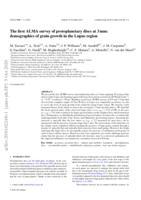The first ALMA survey of protoplanetary discs at 3 mm: demographics of grain growth in the Lupus region
We present the first ALMA survey of protoplanetary discs at 3 mm, targeting 36 young stellar objects in the Lupus star-forming region with deep observations (sensitivity 20–50
|$\mu$|
Jy beam
−1

) at ∼0.35 arcsec resolution (∼50 au). Building on previous ALMA surveys at 0.89 and 1.3 mm that observed the complete sample of Class II discs in Lupus at a comparable resolution, we aim to assess the level of grain growth in the relatively young Lupus region. We measure 3 mm integrated fluxes, from which we derive disc-averaged 1–3 mm spectral indices. We find that the mean spectral index of the observed Lupus discs is
|$\alpha _\mathrm{1-3\, mm}=2.23\pm 0.06$|
, in all cases
|$\alpha _\mathrm{1-3\, mm}\lt 3.0$|
, with a tendency for larger spectral indices in the brightest discs and in transition discs. Furthermore, we find that the distribution of spectral indices in Lupus discs is statistically indistinguishable from that of the Taurus and Ophiuchus star-forming regions. Assuming the emission is optically thin, the low values
|$\alpha _\mathrm{1-3\, mm}\le 2.5$|
measured for most discs can be interpreted with the presence of grains larger than 1 mm. The observations of the faint discs in the sample can be explained without invoking the presence of large grains, namely through a mixture of optically thin and optically thick emission from small grains. However, the bright (and typically large) discs do inescapably require the presence of millimetre-sized grains in order to have realistic masses. Based on a disc mass argument, our results challenge previous claims that the presence of optically thick substructures may be a universal explanation for the empirical millimetre size-luminosity correlation observed at 0.89 mm.

